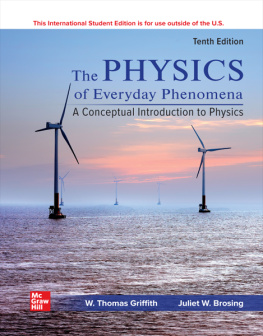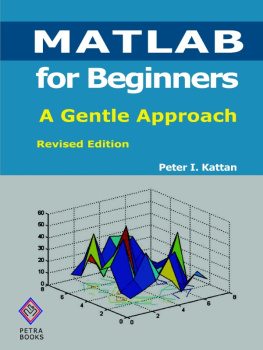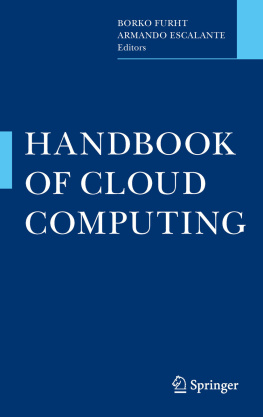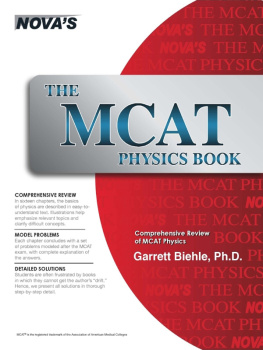Armando Bukele Kattán - Clarifying Concepts in Physics
Here you can read online Armando Bukele Kattán - Clarifying Concepts in Physics full text of the book (entire story) in english for free. Download pdf and epub, get meaning, cover and reviews about this ebook. year: 2013, publisher: Modern Physics, genre: Science. Description of the work, (preface) as well as reviews are available. Best literature library LitArk.com created for fans of good reading and offers a wide selection of genres:
Romance novel
Science fiction
Adventure
Detective
Science
History
Home and family
Prose
Art
Politics
Computer
Non-fiction
Religion
Business
Children
Humor
Choose a favorite category and find really read worthwhile books. Enjoy immersion in the world of imagination, feel the emotions of the characters or learn something new for yourself, make an fascinating discovery.

- Book:Clarifying Concepts in Physics
- Author:
- Publisher:Modern Physics
- Genre:
- Year:2013
- Rating:5 / 5
- Favourites:Add to favourites
- Your mark:
- 100
- 1
- 2
- 3
- 4
- 5
Clarifying Concepts in Physics: summary, description and annotation
We offer to read an annotation, description, summary or preface (depends on what the author of the book "Clarifying Concepts in Physics" wrote himself). If you haven't found the necessary information about the book — write in the comments, we will try to find it.
Clarifying Concepts in Physics — read online for free the complete book (whole text) full work
Below is the text of the book, divided by pages. System saving the place of the last page read, allows you to conveniently read the book "Clarifying Concepts in Physics" online for free, without having to search again every time where you left off. Put a bookmark, and you can go to the page where you finished reading at any time.
Font size:
Interval:
Bookmark:
Someone said: We have traveled a lot, and you are barely starting.
The other replied: Remember that in your long journey, you also started with a first step.
The first asked him again: What if you are in the wrong path?
And the other answered: My mistake wouldnt be as relevant as yours. I have traveled a lot less than you.
Anonymous.
Clarifying Concepts in Physics
Copyright by Armando Bukele Kattn
All rights reserved according to International and Panamerican Conventions.
Includes 244 sections, considering new concepts and ideas in theoretical physics. Moreover, bibliographical references, index of contents, and glossary of new scientific terms and concepts used in this book.
First printed edition - June 2012
First e-book edition - January 2013
armandobukele@icloud.com

Dr. Armando Bukele Katt n.
Salvadoran
Born: December 16, 1944.
Armando Bukele Kattn obtained his undergraduate degree and his doctorate in Industrial Chemistry from the University of El Salvador, reaching an average of 98.9%, the highest score in the history of the University since its foundation in 1841.
He has other University studies in philosophy, journalism, chemical engineering, physics, pharmacology, and history. Of well and persistent read, he is a permanent autodidact, reading about different topics, an average between 1200~1500 pages daily for 50 years. President of Synthesis of Central America, a research laboratory with chemistry patents in several countries: Canada (1), India (1), China (1), Brazil (1), USA (4), and El Salvador (8).
He is also a well-respected member of the Salvadoran community. He receives requests for multiple interviews, and is a political analyst and opinion leader. His program, Clarifying Concepts, is one of the most commented TV programs in El Salvador, with over 580 public appearances.
Imagination is more important than knowledge
Albert Einstein
If somebody cant explain a theory in simple and nontechnical terms, then he doesnt really understand it.
Ernest Rutherford
The purpose of this book is not to detail old concepts; only new concepts, to choose the answer of doubtful items, and to show a new possible way of study. It not only contains answers, but also tips, probabilities, and possibilities; and sometimes, only ideas that need deeper studies, or even, some of them to be discarded.
(From section 214)
In the memory of my father and my mother, Humberto Bukele and Victoria Kattn de Bukele, with permanent love. Both are living together in a more evolved Universe, where the fourth spatial dimension is developed.
To my sons and daughters, whose moments I've spent talking with them, about our ideas and projects, constitute an invaluable time.
Yamile Victoria.
Yamil Alejandro.
Dayana Marilyn.
Emerson Gerardo.
Nayib Armando.
F tima Mariam.
Karim Alberto.
Yusef Al .
Ibrajim Antonio.
Karime Victoria.
This is a textual copy of my manuscript, with no review by other scientists, specialized in specific terms; nor it contains a proper review from experts in the English language. This is not a complete theory, neither it has only proven concepts.
It has new ideas, tips, possibilities, and probabilities. Besides having new and clear concepts, with mathematical results; it has some ideas that need to follow a deeper study, while it has others that will need to be changed, or even discarded.
We considered that it was necessary to print this introductory book right now, because its better to consider new ideas in physics, and to try to find the solutions of the physical incongruences first, before developing beautiful mathematical concepts, that are difficult to apply in the real world. Right now, we prefer to write down new ideas, with some solutions. Other solutions will come later. We hope to publish the second edition in the near future; a new version, properly reviewed, corrected, and extended. Our position at this moment is not to change the Physics; only, to try to change the minds of some smart physicists so they can follow new paths.
There are too many scientists researching the same things, with no results. The acknowledgments will be included in the next edition.
The cosmological constant is a real entity. It existed since the beginning of our Universe, and will continue to exist until the final destiny of itself; but with only one, crucial difference. It is not constant; it is variable. It has been changing continuously since the beginning of time, decreasing its force.
Although its force increases with the distance, that is only true in a specific time. This is important to specify, because with more time, means longer space, and so, we could make a wrong assumption: to consider increasing the cosmological variable proportionally with time. As we said before, the effect is the opposite.
The cosmological variable is not, never was, and never will be, zero. In fact, the cosmological variable is the cause of the dark energy and can be interpreted as kind of overall energy stored in the vacuum of space, and hence its value could be theoretically and experimentally obtained. But such calculations and measurements lead to an enormous difference. Observations show that the cosmological variable, according to quantum mechanical fluctuations in the vacuum of empty space, tend to generate a nonzero cosmological constant whose value is some 120 orders of magnitude larger than experiments show. The explanation about this colossal difference is simple. Quantum mechanic gravity operates only in the Big Bang (or in the center of black holes), and the experimental measure is realized in present time. The cosmological variable decreases with time, in inverse relation to the square of the corresponding cosmic radius.
R Planck (Quantum Mechanic Gravity)
R Present time (Approximately 1.5 x 10 lightyears)
R Planck 1.616 x 10 -33 cm
R Present 1.419 x 10 cm
Difference: (1.419 x 10 /1.616 x 10 -33 ) 7.71 x 10 times
This explains the mismatch between theoretical and experimental results.
The former calculation was correct, even if we didnt use the complete formula, because in a ratio, equal quantities are
eliminated. Nevertheless, the cosmological variable(the actual cosmological constant of Physics ) spreads in six directions (3 spatial dimension x 2 ways: leftright dimension, back forth dimension, and up-down dimension). Its formula is
very simple:
=6/R
And so, we can mathematically obtain the exact value of the cosmological variable at any time, normally approximated (the formula is exact, but the result is an approximate, since we dont know the exact age of the Universe).
Planck Era 2.30 x10 cm -2 (Quantum Gravity)
Present time 1.5 x 10 years.
Present time 2.98 x10 -56 cm -2
The experimental value of the at the present time is 3 x 10 -56 cm -2 > , which accords to our theoretical calculation.
Experimentally, it is impossible to determine if is constant or variable, because its change is imperceptible in a long period of our arithmetical time. For example, in a million years from now, the cosmological variable will diminish in approximately 4 x 10 -60 , changing only its 60 th decimal place.
However, the change in the cosmological variable was enormous in the microcosmos era. The definition of describes a force causing matter to go apart from one another, with an acceleration proportional to their separation in constant time and independent of their masses.
Font size:
Interval:
Bookmark:
Similar books «Clarifying Concepts in Physics»
Look at similar books to Clarifying Concepts in Physics. We have selected literature similar in name and meaning in the hope of providing readers with more options to find new, interesting, not yet read works.
Discussion, reviews of the book Clarifying Concepts in Physics and just readers' own opinions. Leave your comments, write what you think about the work, its meaning or the main characters. Specify what exactly you liked and what you didn't like, and why you think so.










